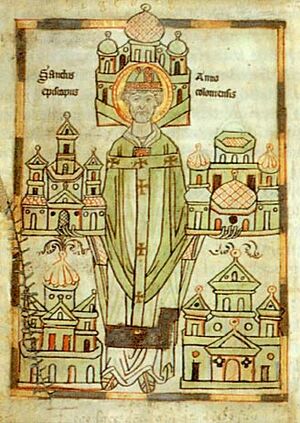Anno II facts for kids
Quick facts for kids Saint Anno of Cologne |
|
|---|---|

Anno showing monasteries he established in a copy of the Vita Annonis Minor
|
|
| Archbishop | |
| Born | c. 1010 Altsteußlingen, Swabia |
| Died | 4 December 1075 (aged 64–65) Siegburg |
| Venerated in | Catholic Church |
| Canonized | 29 April 1183 by Pope Lucius III |
| Major shrine | Michaelsberg Abbey, Siegburg |
| Feast | 4 December |
Anno II (born around 1010 – died December 4, 1075) was a very important leader. He served as the Archbishop of Cologne from 1056 until his death. For a few years, from 1063 to 1065, he even acted as a temporary ruler, called a regent, for the young Emperor Henry IV of the Holy Roman Empire. Anno is honored as a saint in the Catholic Church.
Contents
Anno's Early Life and Rise to Power
Anno was born into a noble family in a place called Altsteußlingen, located in Swabia. He received his education in Bamberg, where he later became the head of the school.
In 1046, Anno became a chaplain (a priest who serves a royal court) for Emperor Henry III. He traveled with the emperor on military campaigns. In 1054, the emperor made him a provost (a high-ranking church official) at the new Cathedral of Goslar. Just two years later, in 1056, Anno was appointed Archbishop of Cologne.
Because he was so close to the emperor, Anno had a lot of influence. He helped other family members get important church positions. For example, his nephew, Burchard, became a bishop in 1059. His brother, Werner, became the Archbishop of Magdeburg in 1063.
Anno's Work and Reforms
People at the time said Anno lived a very simple and strict life. He was also keen on making improvements within the church, known as the Gregorian Reforms. However, he was also a strong opponent to anyone who seemed to threaten the interests of his archdiocese, which was the area he governed as archbishop.
Anno founded a Benedictine monastery called Michaelsberg in Siegburg. This monastery became a key center for the Cluniac Reforms in Germany. These reforms aimed to make monasteries more disciplined and spiritual.
Anno's Role in the Empire
After Emperor Henry III died in 1056, his son Henry IV was only six years old. Archbishop Anno played a major role in governing the empire during the young emperor's childhood.
In April 1062, Anno led a group that took control of young Henry IV in an event known as the Coup of Kaiserswerth. This action removed Henry's mother, Empress Agnes, from power. Anno also secured the important symbols of the empire, called the Imperial Regalia. For a short time, Anno held the main power in the empire. However, he soon had to share this power with other important archbishops. Anno kept the responsibility for Henry's education.
The Archbishop of Cologne traditionally held the important position of archchancellor for the Imperial Kingdom of Italy. This meant Anno had a big say in church matters. In 1061, there was a disagreement about who the rightful Pope was. Anno helped settle this dispute. At a meeting in Mantua in May 1064, he declared Alexander II to be the true Pope.
When Anno returned to Germany, he found that another archbishop had gained more power. The young emperor also did not like Anno much, so Anno lost some influence at court. However, he regained some power when that other archbishop lost his position in 1066. By 1072, Anno had become a top imperial administrator, acting as a mediator in the rising Saxon Rebellion.
Conflict with Cologne Citizens and Death
During the 12th and 13th centuries, the city of Cologne became very wealthy. Its craftspeople, like weavers, goldsmiths, and armor-makers, were famous. Cologne was known as the "German Rome" because it had so many churches and religious communities.
As the city grew richer, its citizens wanted more independence from the archbishop's rule. This led to many conflicts between the archbishops and the city. The first major uprising against an archbishop happened under Anno II, at Easter in 1074. The citizens rebelled, but they were defeated within three days and punished severely.
Anno died at Siegburg Abbey on December 4, 1075, and was buried there.
Veneration
Anno was declared a saint in 1183 by Pope Lucius III. He was known for founding or helping to found several monasteries, including Michaelsberg and Grafschaft. He also built churches. Anno supported the idea that priests should not marry and brought strict rules to many monasteries. He was a very energetic and capable person. His decision to recognize Alexander II as Pope was very important for Emperor Henry IV and for Germany. He is considered the patron saint of people who suffer from gout.
Anno's life was also the subject of two important old books: the Latin Vita Annonis Minor and the Middle High German Annolied.
See Also
| Catholic Church titles | ||
|---|---|---|
| Preceded by Hermann II of Cologne |
Archbishop of Cologne 1056–1075 |
Succeeded by Hildholf |



